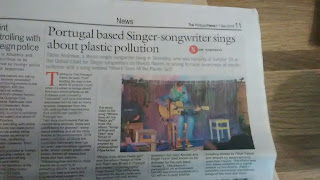Ocean Aid Concert 2020
An Ocean Aid Concert is an idea I have had for several years and been trying to get off the ground. It would be a follow-on from Band Aid and Live Aid but this time would be focused on raising awareness about the threats to the oceans of the world, such as, plastic pollution, overfishing and acidification, all of which are taking a very heavy toll on marine life.
Of course, I would love to think that the day will arrive when many world famous acts would take part in a massive concert that would get televised and receive international publicity and coverage, but right now with the lockdown restrictions due to the Covid-19 pandemic, most concerts this year and big festivals too, have all been cancelled. But not the online ones, where there is no risk of spreading or becoming infected with the disease. So, with the help of my good friend Paul Richmond aka Zest Radio Show, I have come up with an idea to get Ocean Aid Concert 2020 actually happening. If singer-songwriters, singers and bands have songs about the environment they would like to contribute, what I would need is a video of their song. Ideally the songs should have something to do with the oceans but songs about nature and the environment fit with this too. The idea is for me to create a Youtube playlist entitled Ocean Aid Concert and the videos would be included in it, giving everyone some publicity and raising the profile of the Ocean Aid campaign.
At this stage it is all about getting this happening and raising awareness. Fund-raising would be part of a much bigger Ocean Aid Concert, and I have thought money could be raised for organisations that help the oceans and marine life, organisations, such as, Sea Shepherd, and Greenpeace, but all of this would be decided on a later date.
Besides singers and musicians, the Ocean Aid Concert could also include videos of poets with their poems on the subject, readings of prose by writers who want to get involved, and videos of suitable artwork. The Ocean Aid Concert is not just music and song but all creative arts.
SPAM by Filippo Solibello, a Book about Plastic Pollution
Last year a book entitled SPAM - Stop Plastica a Mare was published in Italy. The author is Filippo Solibello, and he is a well-known radio host in his country. I am very proud to say there is a four-page chapter in this book with the title Where Does All The Plastic Go?, which is also the title of a protest song of mine.
The chapter is about me, my song and my ideas about the worldwide problem of plastic pollution. When Filippo interviewed me back in 2018 I told him about my idea for an Ocean Aid Concert and he asked if I minded if he spread the word in Italy. I said, no, not at all, because I just want to see this event happen and it doesn’t matter where! Well, since the publication of SPAM, the author had been touring Italy promoting his book and telling people about my idea. He was also showing videos of my song.
He managed to get a copy of his book to Pope Francis and received media coverage because of that. I was invited to go over to Italy at some point but then the Covid-19 pandemic struck and all plans had to be put on hold. This is why I am thinking we can get this Ocean Aid Concert going online. So please get in touch if you want to be included or can help in any way! Please also share this blog and let’s get Ocean Aid Concert happening! To make a start with this happening I have created an Ocean Aid Concert playlist at Youtube featuring any songs I thought fitted the bill. It includes a few big names, such as, Neil Young, Kate Nash, Jack Johnson and Ed Sheeran.


































